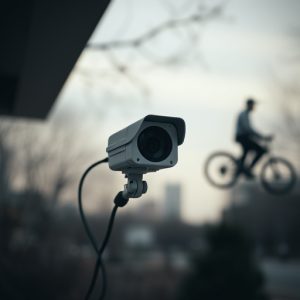Uncover Hidden Surveillance: Tips for Detecting Wireless Spy Cameras & Cloud Links
Wireless spy cameras, using electromagnetic signals like RF or IR, transmit surveillance footage to…….
Wireless spy cameras, using electromagnetic signals like RF or IR, transmit surveillance footage to specialized detectors or smartphone apps via cloud storage accessible worldwide with an internet connection. To protect privacy, individuals should inspect areas for unusual devices, monitor network activity and cloud access points, and use EMF detectors to uncover hidden cameras. Proactive measures, such as regular visual inspections, auditing cloud accounts, and detecting anomalies in network usage, are essential to prevent potential privacy breaches from these advanced devices.
Uncover the invisible threat of wireless spy cameras with our comprehensive guide. In today’s digital age, privacy is paramount. This article equips you to detect hidden surveillance devices and their electromagnetic signals. Learn how to identify suspicious activities, especially focusing on wireless spy cameras and cloud storage links. Discover practical tips for uncovering hidden equipment, ensuring your safety and peace of mind in a connected world.
- Understanding Wireless Spy Cameras and Their Signals
- Detecting Electromagnetic Emissions from Hidden Devices
- Exploring Cloud Storage Links in Surveillance Equipment
- Practical Tips for Uncovering Hidden Spy Cameras
Understanding Wireless Spy Cameras and Their Signals
Wireless spy cameras, often hidden and discreet, have become increasingly sophisticated with advancements in technology. These devices operate through wireless transmission of data, typically using electromagnetic signals to transfer video footage and other information to a remote location or cloud storage. Understanding how these signals work is crucial for detecting and identifying such surveillance devices.
When a wireless spy camera captures video or images, it converts this visual data into digital signals, which are then transmitted wirelessly via radio frequency (RF) or infrared (IR) waves. These signals can be picked up by specialized detectors or even certain applications on your smartphone if the camera is within range. The footage is often stored in cloud storage, making it accessible from anywhere with an internet connection. By understanding these transmission methods and common storage locations, individuals can take proactive measures to protect their privacy and detect potential hidden cameras.
Detecting Electromagnetic Emissions from Hidden Devices
Detecting hidden surveillance devices, such as wireless spy cameras, has become a crucial aspect of privacy protection in today’s digital age. These devices often emit electromagnetic signals that can be detected using specialized equipment. One effective tip is to utilize EMF (Electromagnetic Field) detectors designed for identifying subtle radiation patterns. By scanning for unusual signal readings, you may uncover hidden camera setups, especially those linked to cloud storage for remote access and viewing.
When searching for wireless spy cameras, focus on areas where privacy is a concern, such as offices, homes, or public spaces with high foot traffic. Advanced EMF detectors can pick up on the unique electromagnetic signatures of various devices, including those that transmit data wirelessly. Regularly testing and monitoring these signals can help you stay ahead of potential privacy breaches, ensuring your personal and sensitive information remains secure from hidden surveillance.
Exploring Cloud Storage Links in Surveillance Equipment
Exploring Cloud Storage Links in Surveillance Equipment
In today’s digital age, surveillance equipment has evolved significantly, incorporating wireless spy cameras that seamlessly integrate with cloud storage solutions. These innovative devices allow users to access live feeds and recorded footage from anywhere with an internet connection. By linking these cameras to cloud storage, individuals can remotely monitor their properties, ensuring peace of mind and enhancing security measures.
Wireless spy cameras equipped with cloud storage capabilities offer a range of benefits. For instance, they enable real-time monitoring through smartphone apps, providing users with instant alerts and access to visual data. Moreover, cloud storage ensures backup and remote accessibility, preventing data loss and offering convenience for reviewing footage at any time or location. This advancement in surveillance technology has transformed home security, making it more efficient and accessible than ever before.
Practical Tips for Uncovering Hidden Spy Cameras
Uncovering hidden wireless spy cameras requires a systematic approach and a keen eye for detail. One practical tip is to conduct regular visual inspections, especially in areas where privacy is a concern, like bathrooms, bedrooms, or offices. Look for any unusual devices or gaps that might indicate the presence of a spy camera. These could be small, covert cameras disguised as everyday objects like light bulbs, smoke detectors, or even wallpaper.
Additionally, checking for unexplained activity on your network and cloud storage is crucial. Spy cameras often transmit footage to remote servers without your knowledge. Keep an eye on your data usage and regularly audit your cloud storage accounts. Tools designed to detect anomalies in network activity can also help identify suspicious devices trying to access your system. This proactive approach ensures that you stay one step ahead of potential privacy breaches by hidden wireless spy cameras.
Wireless spy cameras, often hidden and disguised, pose a significant threat to privacy. By understanding their electromagnetic signals and cloud storage links, you can better protect yourself from these clandestine devices. Leveraging practical tips for detection, such as using specialized equipment for signal analysis and monitoring unusual network activity, empowers individuals to uncover hidden surveillance equipment. Staying vigilant in today’s digital age is key to safeguarding your personal space from unwanted intrusion.


